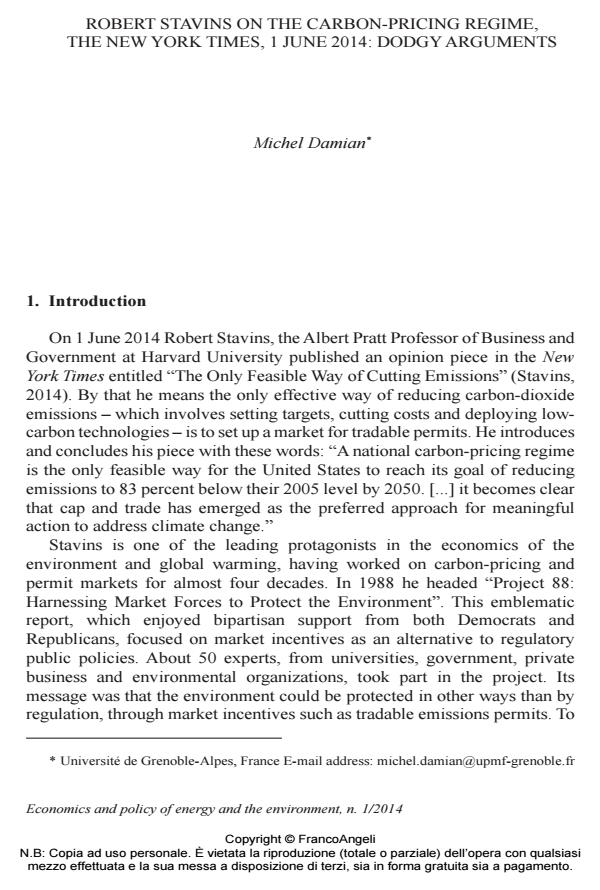Robert stav ins on the carbon-pricing regime, the New York times , 1 june 2014: dodgy arguments
Titolo Rivista ECONOMICS AND POLICY OF ENERGY AND THE ENVIRONMENT
Autori/Curatori Michel Damian
Anno di pubblicazione 2014 Fascicolo 2014/1 Lingua Inglese
Numero pagine 9 P. 53-61 Dimensione file 127 KB
DOI 10.3280/EFE2014-001003
Il DOI è il codice a barre della proprietà intellettuale: per saperne di più
clicca qui
Qui sotto puoi vedere in anteprima la prima pagina di questo articolo.
Se questo articolo ti interessa, lo puoi acquistare (e scaricare in formato pdf) seguendo le facili indicazioni per acquistare il download credit. Acquista Download Credits per scaricare questo Articolo in formato PDF

FrancoAngeli è membro della Publishers International Linking Association, Inc (PILA)associazione indipendente e non profit per facilitare (attraverso i servizi tecnologici implementati da CrossRef.org) l’accesso degli studiosi ai contenuti digitali nelle pubblicazioni professionali e scientifiche
This commentary discusses the opinion piece published on 1 June 2014 by Professor Robert Stavins in The New York Times. Professor Robert Stavins argues that "The Only Feasible Way of Cutting Emissions" is to set up a market for tradable permits. We review and criticize his mains arguments. Our purpose here is not to deny the possibility of carbon trading, but to call for a realistic assessment of the deployment of cap-and-trade systems and their limitations.
Keywords:Cap-and-trade, Command and control, Lead in gasoline, SO2 emissions, California AB32, Climate Change
Jel codes:H23, Q54, Q58
- Bellas A., Lange I. (2005). Are Tradable Permits for Mercury Worthwhile? The Electricity Journal. 18(2), 85-90. DOI: 10.1016/j.tej.2005.01.001
- Buchan D. (2010). California’s Climate Policy – a Model? EV 56. The Oxford Institute for Energy Studies, December 1.
- Burtraw D. (2012). The Institutional Blind Spot in Environmental Economics. DP 12-41, Resources for the Future, Washington, DC, August 24.
- Bushnell J., Peterman C., Wolfram C. (2008). Local Solutions to Global Problems: Climate Change Policies and Regulatory Jurisdiction. Review of Environmental Economics and Policy. 2(2), 175-193. DOI: 10.1093/reep/ren007
- Damian M. (2014). La politique climatique change enfin de paradigme. Economie Appliquée. LXVII (1), 37-72.
- Damian M. (2012). Repenser l’économie du changement climatique. Economie Appliquée. LXV (2), 9-46.
- Fowlie M. et al. (2009). What Do Emissions Markets Deliver and to Whom? Evidence from Southern California’s NOx Trading Program. Working Paper, National Bureau of Economic Research. Cambridge, MA. June.
- Hanemann M. (2008). California’s New Greenhouse Gas Laws. Review of Envionmental Economics and Policy. 2(1), 114-129. DOI: 10.1093/reep/rem030
- Hanemann M., Busch C. (2009). Climate Change Policy in California: Balancing Markets versus Regulation. University of California, Berkeley/Center for Resource Solutions, San Francisco.
- Harrington W., Morgenstern R.D., Nelson P. (2000). On the Accuracy of Regulatory Cost Estimates. Journal of Policy Analysis and Management. 19(2), 297-322. DOI: 10.1002/(SICI)1520-6688(200021)19:2<297::AID-PAM7>3.0.CO;2-X
- Harrison D. Jr. (1999). Tradable permits for air pollution control: The US experience. In: OECD, Implementing Domestic Tradable Permits for Environmental Protection. OECD Proceedings, Paris, 23-51.
- Navarro M. (2012). Reaping a Bonus From Cap-and-Trade. The New York Times. January 27.
- Newell R.G., Rogers K. (2003). The U.S. Experience with the Phasedown of Lead in Gasoline. Discussion Paper, Resources for the Future. Washington, D.C., June.
- Perthuis C. (2006). Marché européen : an 1. Mission climat de la Caisse des Dépôts, Lettre trimestrielle 5, Janvier.
- Pool S. (2010). The Proof Is in the Pudding: Regional Greenhouse Gas Initiative Shows Pollution Pricing Works. Center for American Progress. March 22.
- Rabe B. (2007). Environmental Policy and the Bush Era: The Collision Between the Administrative Presidency and State Experimentation. Publius: The Journal of Federalism. 37(3), 413-431. DOI: 10.1093/publius/pjm007
- Schelling T.C. (1983). Incentives for Environmental Protection. Cambridge M.A.: The MIT Press.
- Shin S. (2013). China’s failure of policy innovation: the case of sulphu dioxide emission trading. Environmental Politics. 22(6), 918-934. DOI: 10.1080/09644016.2012.712792
- Stavins R.N. (1988). Project 88: Harnessing Market Forces to Protect Environment. Harvard University.
- Stavins R.N. (2014). The Only Feasible Way of Cutting Emissions. New York Times. June 1.
- Wätzold F. (2004). SO2 Emissions in Germany: Regulation to Fight Walsterben. In: Harrington W., Morgenstern R., Sterner R.D. (Eds), Choosing Environmental Policy: Comparing Instruments and Outcomes in the United States and Europe. Resources for the Future, Washington, DC, 23-40.
- Les grandes orientations de l’accord climatique de Paris 2015 Michel Damian, Mehdi Abbas, Pierre Berthaud, Catherine Aubertin, Michel Damian, Michel Magny, Claude Millier, Jacques Theys, Sébastien Treyer, in Natures Sciences Sociétés /2015 pp.S19
DOI: 10.1051/nss/2015015
Michel Damian, Robert stav ins on the carbon-pricing regime, the New York times , 1 june 2014: dodgy arguments in "ECONOMICS AND POLICY OF ENERGY AND THE ENVIRONMENT" 1/2014, pp 53-61, DOI: 10.3280/EFE2014-001003